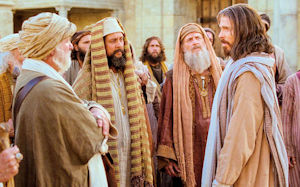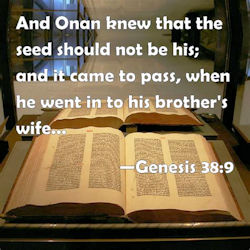The Holy Bible is a book about God, and about the history of humankind and their redemption from sin. Within that context, there is much within the biblical record about the subject of marriage. Sexually, marriage was created and emphasized as a monogamous arrangement between male and female (Genesis 2:21-24), both physically and mentally (Matthew 5:27-28), with equality of demands (1 Corinthians 7:3-4), and which was meant to be permanent (Malachi 2:16a).
But soon after God’s creation of the human animal in Eden, our Father’s grand plan became corrupt through the interference of his evil foe, the devil, who introduced sin into the world. Because sin’s tendency is to derail the human journey, God fine-tuned the marriage arrangement within his selected people, so that there would be some logic and fairness within families. One such institution was the levirate marriage and that is what this article is about.
About a year or so ago, an article was published about some Sadducee1 priests that approached Jesus. Their agenda was to win a debate by using an improbable scenario of multiple marriages under levirate law. The Latin word levir means ‘husband’s brother’. Levirate law states “if a married man dies without children, it was the duty of a brother or other near relative to marry the widow, and the son of the union would be reckoned to be the son of the first husband.”2
The question was posed by the Sadducees because they didn’t believe in the resurrection, which Jesus often preached about. They said to him: “Teacher, Moses wrote for us that if a man’s brother dies, leaving a wife but no children, the man shall marry the widow and raise up children for his brother. Now there were seven brothers; the first married, and died childless; then the second and the third married her, and so in the same way all seven died childless. Finally the woman also died. In the resurrection, therefore, whose wife will the woman be? For the seven had married her,” (Luke 20:28-33, NRSV).3
 You can read the story about this question of the Sadducees, as well as Jesus’ answer, in the article listed in References & Notes,4 but it is only the topic of levirate marriage that we will study in this discourse.
You can read the story about this question of the Sadducees, as well as Jesus’ answer, in the article listed in References & Notes,4 but it is only the topic of levirate marriage that we will study in this discourse.
It should be mentioned that other societies have also been known to practice this custom, including the Punjabis, Huns, Mongols, Tibetans, and Apaches, In Islam, although the Quran does not prohibit a man from marrying his brother’s widow, it does insist that if it were to be done, it should be with the wife’s consent and treated as a normal marriage.5 Many cultures have also practiced “the related custom of sororate marriage, in which a deceased wife’s sister marries the dead woman’s husband.”6
There are a couple stories in the Hebrew Bible relating to levirate marriage, but it must have been rather common for God to specifically give law on its use. One incident is Ruth and Boaz in the Book of Ruth, and another in the Book of Genesis, concerning Tamar within the family of Judah. It is this last one on which we will focus. The story of Tamar is filled with harsh emotional situations, deceit, and forgiveness, and follows unexpected twists and turns that finally lead to great things.
Yesterday & Today
God allows one exception to the laws forbidding incest. Although the marriage to a brother’s widow was forbidden as a general rule (Leviticus 18:16; 20:21), it was regarded as obligatory when there was no son; provided of course, that the two brothers had been dwelling on the same family estate.7
“When brothers reside together, and one of them dies and has no son, the wife of the deceased shall not be married outside the family to a stranger. Her husband’s brother shall go in to her, taking her in marriage, and performing the duty of a husband’s brother to her, and the firstborn whom she bears shall succeed to the name of the deceased brother, so that his name may not be blotted out of Israel,” (Deuteronomy 25:5-6).
Later, that need for the levirate marriage, because of no male child, was changed to not having children of either sex. Hence in Jesus’ day, the Sadducees’ statement said, “if a man’s brother dies, leaving a wife but no children,” (Luke 20:28b).8
![]()
Sometime later, the code was also modified to allow a surviving brother to evade the marriage obligation, by way of the ceremony of halizah (meaning, ‘taking off the shoe’).9 “The ceremony of the taking off of a brother-in-law’s shoe by the widow of a brother who has died childless . . . [releases] the obligation of marrying her, and she becomes free to marry whomever she desires.” Read Deuteronomy 25:7-10 for the full description of the ceremony.10 Although not legally enforced, any brother, who evaded his ‘obligation’, not only forfeited his right, but was publically insulted by the widow, by spiting at him and having his shoe/sandal removed and thrown away.11
Keep in mind that to the Hebrews, married life was a normal life. “Any exception called for apology and explanation. ‘Any Jew who has not a wife is no man’. (Talmud).”12 The three great events in family life — birth, marriage, and death — were important, but marriage was regarded as the most pivotal. That step affected many tribal and family consequences, hence “the selection of the wife and the arrangement of all contractual and financial matters connected with it should be decided upon by the parents or guardians of the couple involved.”13
Therefore, the idea was that the family was a little kingdom of which the father was the king, or absolute ruler. The father, they thought, was God’s representative, and as such he was simply carrying out God’s purpose. For example, selecting a bride for his son, or giving the bride to be married to the son of another, was his decision. “This is as true of the Far East as of the Near East today. Accordingly, as a rule, the young people simply acquiesced, without question or complaint, in what was thus done for them, accepting it as though God had done it directly.”14
In olden times, the levirate marriage not only kept the clan together and provided an heir for the dead brother, but was designed to provide for the welfare of widows and make provision for children to care for their mother in her old age. Today, in theory, the biblical law of levirate marriage for Jews is still presumed to be in force, but in reality, it has fallen more and more into disuse to where it is the rare exception, rather than the rule.
 Modern Jewish women are free from those ancient constraints and live a liberated, and in many cases, an income-producing lifestyle; they are no longer social outcasts if widowed. Because of this, the ceremony of halizah is merely a customary obligation of the religion and is the expected rite performed to free those involved: the widow and the deceased man’s brother.
Modern Jewish women are free from those ancient constraints and live a liberated, and in many cases, an income-producing lifestyle; they are no longer social outcasts if widowed. Because of this, the ceremony of halizah is merely a customary obligation of the religion and is the expected rite performed to free those involved: the widow and the deceased man’s brother.
But, sometimes, all doesn’t go as everyone expects, and there is a modern motion picture concerning just such a situation. If you are easily attracted to ‘love stories’, then you will like this one. Loving Leah is a Hallmark Hall of Fame movie (PG rated) available from some streaming services, as well as on DVD at Amazon and some Christian book stores. The film is about a nonobservant Jewish bachelor and medical doctor (Adam Kaufman), who feels compelled to marry his rabbi brother’s widow, Leah (Lauren Ambrose), to honor him via the ancient Jewish law of levirate marriage. If you have read this article up to this point, you will like this movie (see References & Notes).15
The Sordid Tale of Tamar and Judah
Read all about Tamar’s sorrowful tale in the first chapter of the Hebrew Bible; it is only 30 verses long (Genesis 38:1-30). This story, a disconnected and paradoxical tale, is mysteriously inserted into the story of Joseph’s sale into slavery. While there is debate, as to the reason for this self-contained story interrupting the Joseph narrative, I think it was necessary to show it happened around the same time.16
It’s placement here does serve to “magnify the grace of God when we remember that the Lord Jesus was descended from Judah (Luke 3:33).”17 Tamar, one of five women mentioned in Jesus’ genealogy (Matthew 1), had a son whose descendants included both King David and Jesus Christ.
Here is the story. Judah takes a Canaanite woman to be his wife and they have three sons: Er (the oldest), Onan, and Shelah (the youngest). Per ancient tradition, when the older son reached the proper age, Judah obtained a wife for Er, and her name was Tamar. However, Er was sinful of some unspecified offense and died by God’s hand, before producing any children. The father invokes the levirate custom and the second son, Onan, marries his dead brother’s widow. As already mentioned, offspring would legally be recognized as his brother’s, not his own.18
 Onan knew that the offspring would not be his, so during sexual relations with Tamar, he spilled his semen on the ground. God took his life, because “Onan repeatedly used that law for sexual gratification; he took advantage of the situation, but refused the responsibility that went with it.”19
Onan knew that the offspring would not be his, so during sexual relations with Tamar, he spilled his semen on the ground. God took his life, because “Onan repeatedly used that law for sexual gratification; he took advantage of the situation, but refused the responsibility that went with it.”19
Because Onan spilled his seed on the ground, sometimes his name is referenced by the term onanism,20 which is applied to the act of masturbation, because of wasting of the semen when males masturbate. It is also applied to ejaculating outside the vagina during intercourse (coitus interruptus). What a way for one’s name to be remembered in history books for thousands of years! For an interesting biblical study on the subject of pleasing oneself or of satisfying one’s desires, see the article titled “Masturbation: Is It a Sin?” listed in References & Notes at the end of this discourse.21
Anyway, let us get back to the story. After Onan’s death, Judah told his daughter-in-law, Tamar, to remain a widow in her father’s house until his youngest son, Shelah, grew-up (he was still just a child). So, Tamar went back home to her family. But Judah was just deceiving Tamar, because in his mind, he feared that he may lose his last son, like his brothers. He had no intention of letting Shelah marry her.
As a side note, in the pseudepigraphical Testament of Judah, some of the blame for the son’s actions was because of their Canaanite mother’s beliefs and Judah’s lack of making the corrections needed. (See chapters 10, 11, 12 of the Testament of Judah).22
Later, Judah’s wife died. After the time of mourning, he was planing to travel to another location, where his sheep would receive shearing. His son, Shelah, was now grown-up, but still no arrangements were being made for the levirate marriage. So, when Tamar was told of his plans to travel, she devised a plan of her own.
“Having been deceived by Judah earlier, Tamar cunningly set about to deceive her father-in-law. In order to get Judah to fulfill his family’s obligation to produce an heir for Er and remove the stigma of her childlessness, Tamar apparently took advantage of her father-in-law’s immoral character.”23
Taking off her widow’s mourning clothes, she put on other clothes and a veil, and waited for Judah to come past her on his journey along the road. Some academics suggest she was posing as a common prostitute and lured Judah into sin, but that is not quite accurate; she posed as a Canaanite temple prostitute, considered a sacred position. We know this because common Near East prostitutes always remained unveiled,24 while Canaanite cult prostitutes were heavily veiled, and not just veiled while waiting between customers, but during the act of intercourse, as well.25 This is the main reason Judah didn’t recognize Tamar.
 Tamar was desperate, but she was a woman who refused to be intimidated, manipulated, or ignored.26 Judah had something she needed, and whatever attire, attitude, or action it took, she was going to get it. As one female author implied, “Those of us who have spent more than one Saturday night sitting on a barstool, dressed like a prostitute, hoping some man would give us an identity — girlfriend, fiancée, wife, mother to his children, something, anything — live with a deep-down fear that we would get only what we’d advertised for: sex. We understand the power of a veil.”27
Tamar was desperate, but she was a woman who refused to be intimidated, manipulated, or ignored.26 Judah had something she needed, and whatever attire, attitude, or action it took, she was going to get it. As one female author implied, “Those of us who have spent more than one Saturday night sitting on a barstool, dressed like a prostitute, hoping some man would give us an identity — girlfriend, fiancée, wife, mother to his children, something, anything — live with a deep-down fear that we would get only what we’d advertised for: sex. We understand the power of a veil.”27
So, he more likely propositioned her than the other way around, especially since the Bible indicates he said, “Let me have sex with you,” (Genesis 38:18, NLT). At least his approach was direct and to the point, no beating around the bush for this guy.
Tamar asked, “How much will you pay to have sex with me?” (Genesis 38:16, NLT). The deal was made for the price of one young goat. Not having the goat with him, he left collateral consisting of his personal seal (signet) and attached cord, as well as his staff (cane), and a promise to return with the goat. The deal was concluded and the deed was done, and then he left. After his departure, Tamar took off her veil, put her widow’s clothes back on, and went home.
Judah did later send his friend to retrieve his possessions and deliver the goat, but no such prostitute could be found. In his search, his friend inquired about the location of the qedêshâh (Hebrew word for a sacred sex worker); another reason to indicate it was a Canaanite temple prostitute. Finally, his friend came back without the collateral items and returned the goat to Judah.
Three months later, Judah receives word that his daughter-in-law was pregnant. And since she had an obligation to remain chaste, unless married to Shelah, he figured she must have engaged into intercourse as a whore. He demanded she be brought out to be burned.
Under ancient law, burning was the penalty imposed on any woman who had illicit sex (later it would be changed to stoning). Since this incident took place in the patriarchal period, Judah had total authority over the members of his household. As the head of the family, he exercised his power of life and death and required an immediate solution. This is the only place in the Bible where an individual had the power to order the execution of another for adultery.29
 When ordered to be burned, Tamar sent to Judah the security items of their previous encounter months before (seal, cord, and staff), along with the message that the owner of those things was the one who made her pregnant. Of course, Judah recognized them as his own and he immediately released Tamar. He said, “She is more in the right than I, since I did not give her to my son Shelah.” Then the Bible states, “And he did not lie with her again,” (Genesis 38:26b). A pseudepigraphical text quotes Judah as also saying, “Afterward I went to Egypt to Joseph on account of the famine,” (Judah 12:11, Testament of Judah).30 This would give good reason why this narrative is positioned in the Bible amidst Joseph’s story.
When ordered to be burned, Tamar sent to Judah the security items of their previous encounter months before (seal, cord, and staff), along with the message that the owner of those things was the one who made her pregnant. Of course, Judah recognized them as his own and he immediately released Tamar. He said, “She is more in the right than I, since I did not give her to my son Shelah.” Then the Bible states, “And he did not lie with her again,” (Genesis 38:26b). A pseudepigraphical text quotes Judah as also saying, “Afterward I went to Egypt to Joseph on account of the famine,” (Judah 12:11, Testament of Judah).30 This would give good reason why this narrative is positioned in the Bible amidst Joseph’s story.
In a summation of this part of the story line, one author suggested that Tamar’s sexual ambush of Judah on the side of the road was the act of a courageous and resourceful woman. She refused to passively accept the fate that the patriarchy of ancient Israel decreed for a childless widow. She was a woman who stood up for her legal rights in the only manner available to a woman of her time and place.31
There is More to the Story
 During delivery, Tamar had twin sons (Zerah and Perez), but the birthing was complicated. Oddly, “while still in the womb, Zerah puts out his hand. The midwife accordingly ties a scarlet thread around Zerah’s wrist. But then the hand goes back in,” and the other brother, Perez, is first born. Next, Zerah is then born with the scarlet thread still tied to his hand. Later in the Bible, Perez (first born) is mentioned as an ancestor of both King David and Jesus.32
During delivery, Tamar had twin sons (Zerah and Perez), but the birthing was complicated. Oddly, “while still in the womb, Zerah puts out his hand. The midwife accordingly ties a scarlet thread around Zerah’s wrist. But then the hand goes back in,” and the other brother, Perez, is first born. Next, Zerah is then born with the scarlet thread still tied to his hand. Later in the Bible, Perez (first born) is mentioned as an ancestor of both King David and Jesus.32
I liked one blogger’s insightful conclusion of the Judah-Tamar story. Writing to other women, she said, “we really are not that different from Tamar. We find ourselves in situations in which we are clearly not treated fairly. We search for a way out of our trials while praying for patience and faith to make it through them.”33
The music selection for this article is not a professional production, but recorded with a single camera angle in a home living room. Nevertheless, the duet performance is done well and is rather cute. The title of the song is ‘Judah and Tamar’ and it is sung by Jordan Paterson and Logan Otis. There is no information as to the songwriter. Selected lyrics are below and the music video is listed in References & Notes.34

(Judah sings)
My name is Judah,
Father of three
When my firstborn died, it was such a surprise
And I didn’t know what to do with his wife
(Tamar sings)
I’m Tamar,
And according to Levirate Law
I must bear a child to reconcile
But Judah said Shelah may take a while
(Judah sings)
So my wife died and I went to shear my sheep
But I saw this girl, prettiest in the world,
And I wanted her to sleep with me
(Tamar sings)
So he did
But he didn’t know it was me
He wouldn’t give me his son, so now I’ll give him a son
And make him give me his staff as a pledge for sheep
(Judah sings)
But I found out
That Tamar was pregnant with twins
I wanted her to burn, but then in turn
She told me that the kids were mine
![]()
Copyright © 2021, Dr. Ray Hermann
OutlawBibleStudent.org
→ Leave comments at the end, after ‘References & Notes’.
You can see our basic rules for comments by clicking “The Fine Print” on the top menu bar. Your email address will NOT be published.
References & Notes
- Sadducee: member of a Jewish priestly sect that flourished before the destruction of the Second Temple of Jerusalem in 70 AD.
“Sadducee” (Britannica, Encyclopædia Britannica Inc., 20 July 1998), https://www.britannica.com/topic/Sadducee - France, R. T., The Gospel of Mark: A Commentary on the Greek Text, New International Greek Testament Commentary, (Grand Rapids, MI; W.B. Eerdmans; Paternoster Press, 2002), pp. 472-473.
- Unless otherwise noted, all scripture is from New Revised Standard Version Bible, (Division of the National Council of the Churches of Christ in the USA, 1989). Used with permission.
- Hermann, Ray, “Those worthy of being raised from the dead will neither marry nor be given in marriage. — What did Jesus mean?” (OBS, 12 January 2020), https://outlawbiblestudent.org/those-worthy-of-being-raised-from-the-dead-will-neither-marry-nor-be-given-in-marriage-what-did-jesus-mean/
- “Levirate marriage”, (Wikipedia, Wikimedia Foundation, 3 May 2021), https://en.wikipedia.org/wiki/Levirate_marriage
- “Levirate Marriage”, (New World Encyclopedia, 3 July 2018), https://www.newworldencyclopedia.org/entry/Levirate_Marriage
- Singer, Isidore, (Ed.), The Jewish Encyclopedia: A Descriptive Record of the History, Religion, Literature, and Customs of the Jewish People from the Earliest Times to the Present Day, (New York and London: Funk & Wagnalls, 1901–1906), vol. 8, p. 45.
- Ibid.
- Eisenberg, Ronald, “Levirate Marriag and Halitzah”, (My Jewish Learning, retrieved 3 May 2021), https://www.myjewishlearning.com/article/levirate-marriage-and-halitzah/
- Singer, Isidore, (Ed.), The Jewish Encyclopedia (see above), vol. 6, pp. 171-172.
- Paterson, William P., in A Dictionary of the Bible: Dealing with Its Language, Literature, and Contents Including the Biblical Theology, (Ed.) James Hastings, (New York: Charles Scribner’s Sons, 1911–1912), vol. 3, p. 269.
- Eager, George. B., in The International Standard Bible Encyclopædia, (Ed.) James Orr, (Chicago: the Howard-Severance Company, 1915,), vol. 3, p. 1996.
- Ibid., vol. 3, p. 1997.
- Ibid.
- Loving Leah is a heart-warming story of a handsome Washington, DC doctor and a young New York woman, who fall in love at an unusual time — after they get married via the ancient Jewish law of levirate marriage. Leah was married to the deceased Orthodox rabbi, Benjamin, whose brother, Jake, is a successful cardiologist and a non-practicing Jew. It was originally aired on CBS as a Hallmark Hall of Fame movie on January 25, 2009. The film is directed by Jeff Bleckner.
“Loving Leah”, (Wikipedia, Wikimedia Foundation, 30 April 2021), https://en.wikipedia.org/wiki/Loving_Leah - Mays, James Luther, (Ed.), Harper’s Bible Commentary, (San Francisco: Harper & Row, 1988), p. 114.
- MacDonald, William, Believer’s Bible Commentary: Old and New Testaments, (Ed.), Arthur Farstad, (Nashville: Thomas Nelson, 1995), pp. 71–72.
- Mays, James Luther, (Ed.), Harper’s Bible Commentary, (see above).
- Ross, Allen P., The Bible Knowledge Commentary: An Exposition of the Scriptures, (Wheaton, IL: Victor Books, 1985), vol. 1, p. 88.
- Onanism: masturbation; self-gratification – from Latin onanismus, from Onan, son of Judah (Genesis 38:9)
Merriam-Webster’s Collegiate Dictionary, 11th ed., (Springfield, MA: Merriam-Webster, Inc., 2003). - Hermann, Ray, “Masturbation: Is It a Sin?” (OBS, 23 May 2018), https://outlawbiblestudent.org/masturbation-is-it-a-sin/
- “The Testament of Judah: the Fourth Son of Jacob and Leah”, (The Firmament, retrieved 11 May 2021), https://www.thefirmament.org/scripture/testaments/testament-of-judah/
- Bergen, Robert D., CSB Study Bible: Notes, (Nashville TN: Holman Bible Publishers, 2017), p. 66.
- Buttick, George A., Interpreter’s Dictionary of the Bible, (New York: Abingdon Publishing, 1963), p. 74.
- Higgs, Liz Curtis, Really Bad Girls of the Bible, (Colorado Springs, CO: Waterbrook Press, 2000), p. 212.
- Kirsch, Jonathan, The Harlot by the Side of the Road: Forbidden Tales of the Bible, (New York: Ballantine Books, 1997), p. 143.
- Higgs, Liz Curtis, Really Bad Girls of the Bible, (see above).
- Strong’s Hebrew #6948, קְדֵשָÑה, qedêshâh, fem. of 6945; a female devotee (by prostitution) to licentious idolatry.
Strong, James, The New Strong’s Complete Dictionary of Bible Words, (Nashville, TN: Thomas Nelson Publishers, 1996). - Bar, Shaul, “The Punishment of Burning in the Hebrew Bible”, (Scientific Electronic Library Online, South Africa, 2012), pp. 29-30, http://www.scielo.org.za/pdf/ote/v25n1/02.pdf
- “The Testament of Judah: the Fourth Son of Jacob and Leah”, (The Firmament, retrieved 11 May 2021), https://www.thefirmament.org/scripture/testaments/testament-of-judah/
- Kirsch, Jonathan, The Harlot by the Side of the Road, (see above), p. 137.
- Ecker, Ronald L., And Adam Knew Eve: A Dictionary of Sex in the Bible, (Palatka, FL: Hodge & Braddock Publishers, 1995), p. 99.
- “The Story of Tamar: How to Have Patience When Life Isn’t Fair”, (Lessons from Home, retrieved 11 May 2021), https://lessonsfromhome.co/the-story-of-tamar-how-to-have-patience-when-life-isnt-fair/
- “Judah and Tamar”, Artists: Jordan Paterson and Logan Otis; uploaded to YouTube on 9 November 2019, (no album, author, licensing, or copyright listed; used under ‘fair use’ copyright for teaching under Section 107 of Copyright Act of 1976) – MUSIC VIDEO: https://youtu.be/XyUyJAWzvXo


Beautiful story, amazing how God can turn what seems like a bad situation into something good. Judah was repentant and took full responsibility for his action. He became the one chosen to be in the line of Christ genealogy. Tamar also was a blessed woman, she became grand-mother of Jesus through genealogy. It’s a beautiful story! Thanks for sharing.
Thank you for reading this article and for taking the time to leave a comment. It is appreciated.